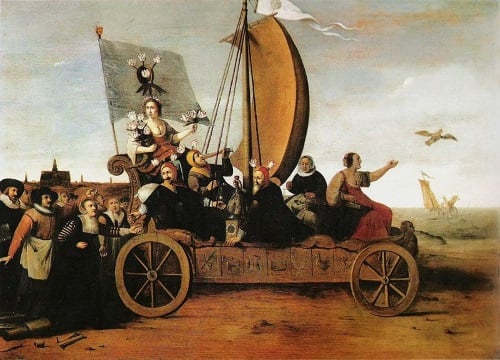Skip Knox submitted a new blog post:
History for Fantasy Writers: Wagons, Carts and Trucks
by E.L. Skip Knox

It should be simple: you want to describe a scene of people coming into a town for market. Or maybe it's just a chance encounter on a road with some merchants. Or maybe it’s peasants on their way to market, loaded down with hay or squash. What are they carrying it in?
Answering the question isn't a matter of a few minutes or even a few hours. There are whole books on this topic of wagons and transport, and the answers are complicated. Eh, oh well. Welcome to the Middle Ages, right? Everything here is complicated.
But for the writer, complicated is where the fun is.
Overview
Carts came first, then wagons, then trucks.
Even that simple statement is tricky, for "truck" is a verb that goes way back, at least to the early 17th century, but it was not used in the sense of a vehicle for carrying heavy loads until the late 18th century. So that part is easy: no trucks in the Middle Ages.
Carts are the oldest form of man-made transport. They appear with the earliest traces of cities, pulled by all sorts of animals from dogs to humans, and from goats to horses. A handcart is probably the oldest form, since all other types of carts require some sort of harness for the animal. They're also the cheapest, so if your characters are poor (and if your world is quasi-medieval, then 80% or more of your characters are in fact poor), then they're likely to be using a handcart. A...
Continue reading the Original Blog Post.
History for Fantasy Writers: Wagons, Carts and Trucks
by E.L. Skip Knox

It should be simple: you want to describe a scene of people coming into a town for market. Or maybe it's just a chance encounter on a road with some merchants. Or maybe it’s peasants on their way to market, loaded down with hay or squash. What are they carrying it in?
Answering the question isn't a matter of a few minutes or even a few hours. There are whole books on this topic of wagons and transport, and the answers are complicated. Eh, oh well. Welcome to the Middle Ages, right? Everything here is complicated.
But for the writer, complicated is where the fun is.
Overview
Carts came first, then wagons, then trucks.
Even that simple statement is tricky, for "truck" is a verb that goes way back, at least to the early 17th century, but it was not used in the sense of a vehicle for carrying heavy loads until the late 18th century. So that part is easy: no trucks in the Middle Ages.
Carts are the oldest form of man-made transport. They appear with the earliest traces of cities, pulled by all sorts of animals from dogs to humans, and from goats to horses. A handcart is probably the oldest form, since all other types of carts require some sort of harness for the animal. They're also the cheapest, so if your characters are poor (and if your world is quasi-medieval, then 80% or more of your characters are in fact poor), then they're likely to be using a handcart. A...
Continue reading the Original Blog Post.

 Troubadour
Troubadour
 Auror
Auror Myth Weaver
Myth Weaver Acolyte
Acolyte